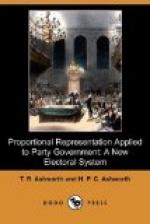of these two factions again threatened to make government
impossible. In administration the evil was felt
most; the union of ministers of both parties was proving
unworkable. So fickle did legislation become that
no one could say one day what the House would do the
next. It was at this crisis, and about the year
1693, that William III., who cared more for a strong
administration than for political differences, created
what is known as cabinet government, and, as Professor
Gardiner says, “refounded the government of
England on a new basis.” Recognizing that
power should not be separated from responsibility,
he affirmed the principle that the ministers of state
should be selected from the party which had a majority
in the House of Commons. But the time was not
yet ripe for the complete application of this principle.
Early in the eighteenth century Sir Robert Walpole
set the example of resigning when he no longer possessed
the confidence of a majority of the House of Commons;
but in the latter half of the century the great Earl
of Chatham introduced again the practice of selecting
ministers irrespective of party. Despite the
fact that he was supported by the personal influence
of George III., the attempt failed. A succession
of weak ministries followed; and out of the confusion
the modern division of Liberals and Conservatives emerged.
Thus it was not until the beginning of the present
century that the doctrines of the solidarity of the
Cabinet and its complete dependence on a majority
of the House of Commons were thoroughly developed in
their present form. England, now grown into the
United Kingdom, had at last, after six centuries of
strife, won her national independence, and for one
brief century has enjoyed a full measure of self-government.
+Comparison of the Two Stages.+—How do
the conditions presented by the nineteenth century
differ from those of the fourteenth? And how is
the problem of representation affected? We have
seen that the great forces which animated the nation
in the fourteenth century were organization and leadership.
Have these forces ceased to operate? Assuredly
not. In the fourteenth century we had a united
people organized under its chosen leaders against
the encroachments of the King and nobility on its
national liberty. In the nineteenth century the
people have won their political independence, but
the struggle is now carried on between two great organized
parties. The principle of leadership is still
as strong as ever. The careers of Pitt, Peel,
Palmerston, Beaconsfield, and Gladstone attest that
fact. The one great difference, then, between
the fourteenth and the nineteenth centuries is that
instead of one party there are two. The problem
of representation in the fourteenth century was to
keep the people together in one united party, and to
allow them to select their most popular leaders.
Surely the problem is different in the nineteenth
century. The requirements now are to organize
the people into two great parties, and to allow each




